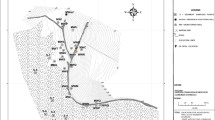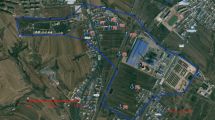Abstract
The widespread use of unconventional drilling involving hydraulic fracturing (“fracking”) has allowed for increased oil-and-gas extraction, produced water generation, and subsequent spills of produced water in Colorado and elsewhere. Produced water contains BTEX (benzene, toluene, ethylbenzene, xylene) and naphthalene, all of which are known to induce varying levels of toxicity upon exposure. When spilled, these contaminants can migrate through the soil and contaminant groundwater. This research modeled the solute transport of BTEX and naphthalene for a range of spill sizes on contrasting soils overlying groundwater at different depths. The results showed that benzene and toluene were expected to reach human health relevant concentration in groundwater because of their high concentrations in produced water, relatively low solid/liquid partition coefficient and low EPA drinking water limits for these contaminants. Peak groundwater concentrations were higher and were reached more rapidly in coarser textured soil. Risk categories of “low,” “medium,” and “high” were established by dividing the EPA drinking water limit for each contaminant into sequential thirds and modeled scenarios were classified into such categories. A quick reference guide was created that allows the user to input specific variables about an area of interest to evaluate that site’s risk of groundwater contamination in the event of a produced water spill. A large fraction of produced water spills occur at hydraulic-fracturing well pads; thus, the results of this research suggest that the surface area selected for a hydraulic-fracturing site should exclude or require extra precaution when considering areas with shallow aquifers and coarsely textured soils.







Similar content being viewed by others
References
ASTM. (2015). Standard guide for risk-based corrective action applied at petroleum release sites, (E2081-0), 1–55. https://doi.org/10.1520/E1739-95R15.2.
Babcock, H. M., Bjorklund, L. J., & Kister, L. R. (1956). Ground-water geology of parts of Laramie and Albany Counties Wyoming, and Weld County. Colorado: Department of the Interior.
Balseiro-Romero, M., Kidd, P. S., & Monterroso, C. (2016). Leachability of volatile fuel compounds from contaminated soils and the effect of plant exudates: a comparison of column and batch leaching tests. Journal of Hazardous Materials, 304, 481–489.
Benko, K. L., & Drewes, J. E. (2008). Produced water in the western United States: geographical distribution, occurrence, and composition. Environmental Engineering Science, 25(2), 239–246. https://doi.org/10.1089/ees.2007.0026.
Collins, C., Grank, L., & Ales, N. (2002). Remediation of BTEX and trichloroethene. Environmental Science and Pollution Research, 9(1), 86–94.
Colorado Geological Survey. (1995). Groundwater Atlas. http://coloradogeologicalsurvey.org/water/groundwater-atlas/. Accessed 5 Jan 2017.
Colorado Oil and Gas Conservation Commission. (n.d.). Inspection/incident inquiry. https://cogcc.state.co.us/cogis/IncidentSearch.asp. Accessed 6 June 2017.
Colorado Oil and Gas Conservation Commission. (2011). Oil and gas industry spills and releases. http://dnr.state.co.us/SiteCollectionDocuments/SpillsAndReleases.pdf. Accessed 10 March 2014.
Colorado Oil and Gas Conservation Commission. (2012). 2011 Report to the Water Quality Control Commission and Water Quality Control Division of the Colorado Department of Public Health and Environment. http://cogcc.state.co.us/documents/library/Technical/WQCC_WQCD%20Annual%20Reports/WQCC10_11RPT.pdf. Accessed 10 June 2015.
Colorado State University & U.S. Department of Agriculture. (n.d.). CoAgMet crop ET access page. http://ccc.atmos.colostate.edu/cgi-bin/extended_etr_form.pl. Accessed 5 Nov2015.
Croute, F., Poinsot, J., Gaubin, Y., Beau, B., Simon, V., Murat, J. C., & Soleilhavoup, J. P. (2002). Volatile organic compounds cytotoxicity and expression of HSP72, HSP90 and GRP78 stress proteins in cultured human cells. Biochimica et Biophysica Acta - Molecular Cell Research, 1591(1–3), 147–155. https://doi.org/10.1016/S0167-4889(02)00271-9.
Davis, G. B., Rayner, J. L., Trefry, M. G., Fisher, S. J., & Patterson, B. M. (2005). Measurement and modeling of temporal variations in hydrocarbon vapor behavior in a layered soil profile. Vadose Zone Journal, 4, 225–239. https://doi.org/10.2136/vzj2004.0029.
DrillingEdge. (2017). Oil & gas production in Weld County, CO. http://www.drillingedge.com/colorado/weld-county. Accessed 5 June 2017.
European Chemicals Bureau. (2003). European Union risk assessment report - toluene. Institute for Health and Consumer Protection, 108-88–3(203-625–9), 1–305.
European Chemicals Bureau. (2007a). European Union risk assessment report-naphthalene. Institute for Health and Consumer Protection, 91-20–3(202-49–5), 1–215.
European Chemicals Bureau. (2007b). European Union risk assessment report-ethylbenzene. Institute for Health and Consumer Protection, 100-41–4(202-849–4), 1–76.
European Chemicals Bureau. (2008). European Union risk assessment report-benzene. Institute for Health and Consumer Protection, 71-43–2(200-753–7), 1–339.
Finley, B. (2011). With more wells added daily, activists voice concerns and regulators increase inspections. The Denver Post. http://www.denverpost.com/2011/09/12/drilling-spills-rise-in-colorado-but-fines-rare/#%22It’s. Accessed 17 Jan 2014.
Finley, B. (2014). Oil and gas spills surge, two a day, residents often not notified. The Denver Post. http://www.denverpost.com/2014/07/28/oil-and-gas-spills-surge-two-a-day-residents-often-not-notified/. Accessed 5 Jan 2015.
Gregory, K. B., Vidic, R. D., & Dzombak, D. A. (2011). Water management challenges associated with the production of shale gas by hydraulic fracturing. Elements, 7, 181–186. https://doi.org/10.2113/gselements.7.3.181.
Grigg, N. (n.d.). Citizen’s guide to where your water comes from. Colorado Foundation for Water Education. https://www.yourwatercolorado.org/cfwe-education/water-is/water-planning-a-distribution/51-citizens-guide-to-where-your-water-comes-from. Accessed 10 April 2017.
Gross, S. A., Avens, H. J., Banducci, A. M., Sahmel, J., Panko, J. M., & Tvermoes, B. E. (2013). Analysis of BTEX groundwater concentrations from surface spills associated with hydraulic fracturing operations. Journal of the Air & Waste Management Association, 63(4), 424–432. https://doi.org/10.1080/10962247.2012.759166.
Guerra, K., Dahm, K., & Dundorf, S. (2011). Oil and gas produced water management and beneficial use in the western United States. U.S. Bureau of Reclamation, Department of the Interior, 157.
Hammer, R., Levine, L., & VanBriesen, J. (2012). In fracking’s wake: New rules are needed to protect our health and environment from contaminated wastewater. Natural Resource Defense Council.
Jin, S., & Ray, C. (2015). A GIS-assisted regional screening tool to evaluate the leaching potential of volatile and non-volatile pesticides. Journal of Hydrology, 522, 163–173. https://doi.org/10.1016/j.jhydrol.2014.12.024.
Kargbo, D. M., Wilhelm, R. G., & Campbell, D. J. (2010). Natural gas plays in the Marcellus Shale: challenges and potential opportunities. Environmental Science and Technology, 44(15), 5679–5684. https://doi.org/10.1021/es903811p.
Kasaraneni, V., Kohm, S. E., Eberle, D., Boving, T., & Oyanedel-craver, V. (2014). Enhanced containment of polycyclic aromatic hydrocarbons through organic modification of soils. Environmental Progress & Sustainable Energy, 33(1), 47–54. http://doi.org/10.1002/ep.11749.
Keer, R. A. (2010). Natural gas from shale bursts onto the scene. Science, 328, 1624–1626.
Lawrence, S. J. (2006). Description, properties, and degradation of selected volatile organic compounds detected in ground water—a review of selected literature. U.S. Geological Survey, Department of the Interior, 2006–1338.
O’Neill, B. J., & Thorp, J. H. (2014). Untangling food-web structure in an ephemeral ecosystem. Freshwater Biology, 59(7), 1462–1473. https://doi.org/10.1111/fwb.12358.
Otton, J. K., Zielinski, R. A., Smith, B. D., & Abbott, M. M. (2007). Geologic controls on movement of produced-water releases at US geological survey research Site A, Skiatook lake, Osage county, Oklahoma. Applied Geochemistry, 22, 2138–2154. https://doi.org/10.1016/j.apgeochem.2007.04.015.
Patterson, L. A., Konschnik, K. E., Wiseman, H., Fargione, J., Maloney, K. O., Kiesecker, J., & Saiers, J. E. (2017). Unconventional oil and gas spills: risks, mitigation priorities, and state reporting requirements. Environmental Science and Technology, 51, 2563–2573. https://doi.org/10.1021/acs.est.6b05749.
Pinedo, J., Ibáñez, R., Lijzen, J. P. A., & Irabien, Á. (2013). Assessment of soil pollution based on total petroleum hydrocarbons and individual oil substances. Journal of Environmental Management, 130, 72–79. https://doi.org/10.1016/j.jenvman.2013.08.048.
Salanitro, J. P., Dorn, P. B., Huesemann, M. H., Moore, K. O., Rhodes, I. A., Rice Jackson, L. M., & Wisniewski, H. L. (1997). Crude oil hydrocarbon bioremediation and soil ecotoxicity assessment. Environmental Science & Technology, 31(6), 1769–1776. https://doi.org/10.1021/es960793i.
Simunek, J. (2013). Numerical modeling of contaminant transport using HYDRUS and its specialized modules. Journal of the Indian Institute of Science, 93(2), 265–284.
Skalak, K. J., Engle, M. A., Rowan, E. L., Jolly, G. D., Conko, K. M., Benthem, A. J., & Kraemer, T. F. (2014). Surface disposal of produced waters in western and southwestern Pennsylvania: potential for accumulation of alkali-earth elements in sediments. International Journal of Coal Geology, 126, 162–170. https://doi.org/10.1016/j.coal.2013.12.001.
Goodwin, S., Caleb Douglas, K. C. (2012). Lifecycle analysis of water use and intensity of Noble Energy oil and gas recovery in the Wattenberg Field of northern Colorado. Nobel Energy and Colorado State University.
Todd, G. T., Chessin, R. L., & Colman, J. (1999). Toxicological profile for total petroleum hydrocarbons (TPH). U.S. Department of Health and Human Services, (September), 1–231.
Torres, L., Yadav, O. P., & Khan, E. (2015). A review on risk assessment techniques for hydraulic fracturing water and produced water management implemented in onshore unconventional oil and gas production. Science of the Total Environment, 539(2016), 478–493. https://doi.org/10.1016/j.scitotenv.2015.09.030.
Toxicology data network: Environmental fate and exposure. (2015). http://toxnet.nlm.nih.gov/. Accessed 15 March 2015.
U.S. Environmental Protection Agency. (n.d.). National primary drinking water regulations. https://www.epa.gov/ground-water-and-drinking-water/national-primary-drinking-water-regulations. Accessed 3 March 2013.
U.S. Environmental Protection Agency. (2003a). Contaminant candidate list regulatory determination support document for naphthalene, pp. 1–42.
U.S. Environmental Protection Agency. (2003b). Health effects support document for naphthalene. https://www.epa.gov/sites/production/files/2014-09/documents/support_cc1_naphthalene_healtheffects.pdf. Accessed 15 March 2013.
U.S. Environmental Protection Agency. (2009). Benzene TEACH Chemical Summary (Vol. 1). https://doi.org/10.1017/CBO9781107415324.004.
U.S. Environmental Protection Agency. (2015a). Assessment of the potential impacts of hydraulic fracturing for oil and gas on drinking water resources.
U.S. Environmental Protection Agency. (2015b). Review of state and industry spill data: characterization of hydraulic fracturing-related spills.
U.S. Environmental Protection Agency. (2016). Hydraulic fracturing for oil and gas: Impacts from the hydraulic fracturing water cycle on drinking water resources in the United States, EPA-600-R-16-236Fb.
U.S. Forest Service. (n.d.). Arapaho & Roosevelt National Forests Pawnee National Grassland. https://www.fs.usda.gov/wps/portal/fsinternet/cs/detail/!ut/p/z0/04_Sj9CPykssy0xPLMnMz0vMAfIjo8zijQwgwNHCwN_DI8zPyBcqYKBfkO2oCABZcx5g/?position=Not%2520Yet%2520Determined.Html&pname=Arapaho&ss=110210&navtype=BROWSEBYSUBJECT&pnavid=null&navid=170000000000000&ttype=detail&cid=fsm91_058278. Accessed 25 June 2015.
U.S. Geological Survey. (2006). Fate and transport of petroleum hydrocarbons in soil and ground water at Big South Fork National River and Recreation Area, Tennessee and Kentucky, 2002–2003.
U.S. Geological Survey, Department of the Interior. (2010). Hydrogeology and steady-state numerical simulation of groundwater flow in the Lost Creek Designated Ground Water Basin, Weld, Adams, and Arapahoe Counties, Colorado. Scientific Investigations Report 2010–5082.
Unger, A. J. A., Sudicky, E. A., & Forsyth, P. A. (1995). Mechanisms controlling vacuum extraction coupled with air sparging for remediation of heterogeneous formations contaminated by dense nonaqueous phase liquids. Water Resources Research, 31(8), 1913–1925. https://doi.org/10.1029/95WR00172.
U.S. Geological Society, Colorado Water Institute & Colorado Water Conservation Board. (2015). Evaluation of groundwater levels in the South Platte River Alluvial Aquifer , Colorado, 1953–2012, and design of initial well networks for monitoring groundwater levels, 2015–5015.
Vaezihir, A., Zare, M., Raeisi, E., Molson, J., & Barker, J. (2012). Field-scale modeling of benzene, toluene, ethylbenzene, and xylenes (BTEX) released from multiple source zones. Bioremediation Journal, 16(3), 156–176. https://doi.org/10.1080/10889868.2012.687415.
Veil, J. (2015). U.S. produced water volumes and management practices in 2012. Groundwater Protection Council.
Veil, J. A., Puder, M. G., Elcock, D., & Redweik, R. (2004). A white paper describing produced water from production of crude oil, natural gas, and coal bed methane. U.S. Department of Energy. National Energy Technology Laboratory. Argonne National Laboratory.
Vengosh, A., Jackson, R. B., Warner, N., Darrah, T. H., & Kondash, A. (2014). A critical review of the risks to water resources from unconventional shale gas development and hydraulic fracturing in the United States. Environmental Science & Technology, 48(15), 8334–8348. https://doi.org/10.1021/es405118y.
Vidic, R. D., Brantley, S. L., Vandenbossche, J. M., Yoxtheimer, D., & Abad, J. D. (2013). Impact of shale gas development on regional water quality. Science, 340(6134), 1235009:1-1235009:9. https://doi.org/10.1126/science.1235009.
Zoback, M., Copithorne, B., & Kitasei, S. (2010). Addressing the environmental risks from shale gas development. Worldwatch Institute. Natural Gas and Sustainable Energy Initiative, pp. 1–19.
Funding
This work was funded by the National Science Foundation, Graduate Research Fellowship Program, award number DGE-0822211 and the Natural Resource Ecology Laboratory James E. Ellis Memorial Scholarship.
Author information
Authors and Affiliations
Corresponding author
Rights and permissions
About this article
Cite this article
Shores, A., Laituri, M. & Butters, G. Produced Water Surface Spills and the Risk for BTEX and Naphthalene Groundwater Contamination. Water Air Soil Pollut 228, 435 (2017). https://doi.org/10.1007/s11270-017-3618-8
Received:
Accepted:
Published:
DOI: https://doi.org/10.1007/s11270-017-3618-8




